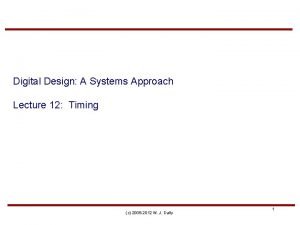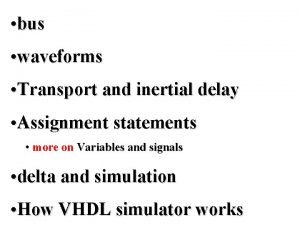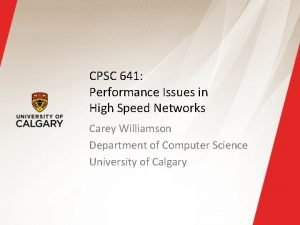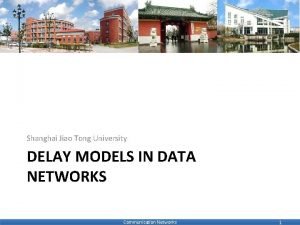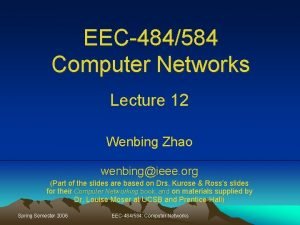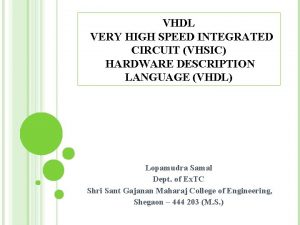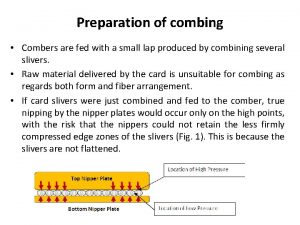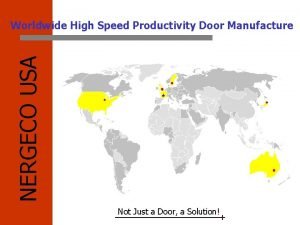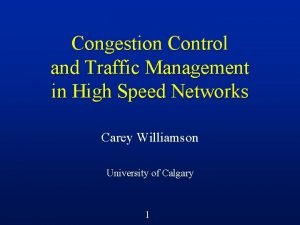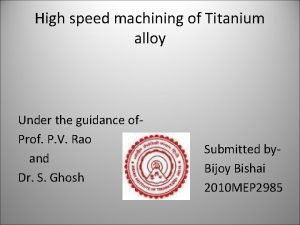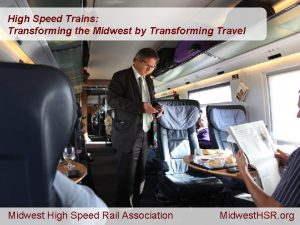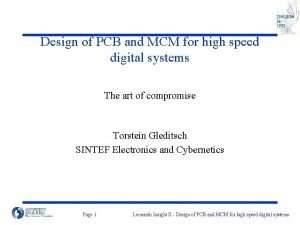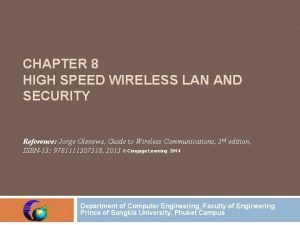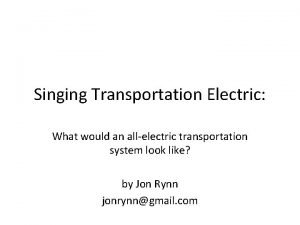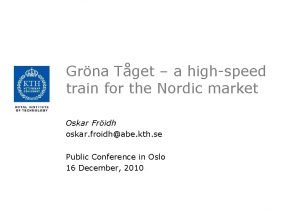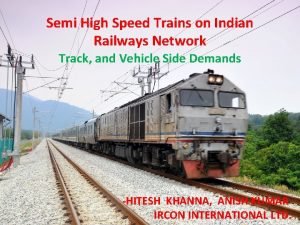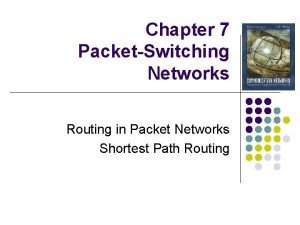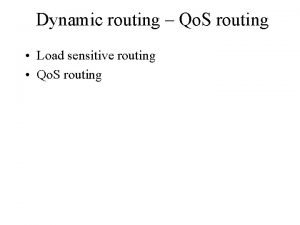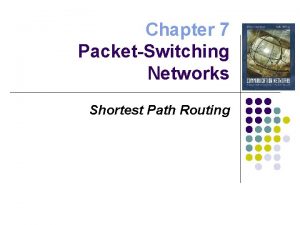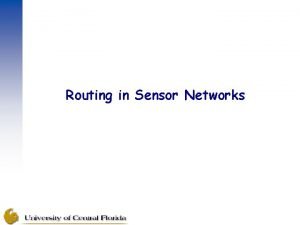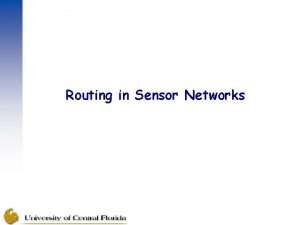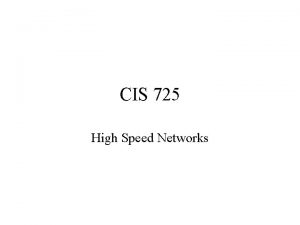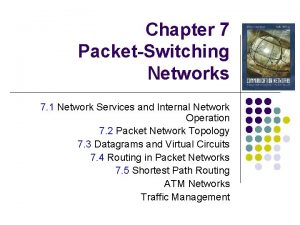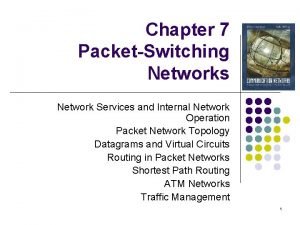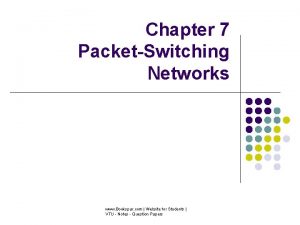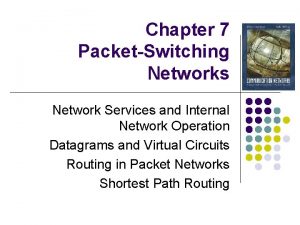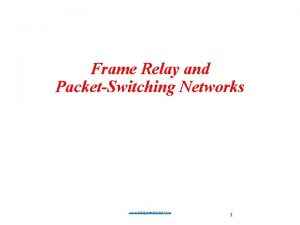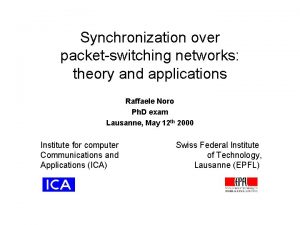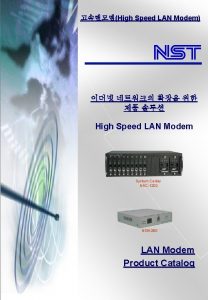Delay Sensitive Routing for High Speed Packetswitching Networks
















































- Slides: 48

Delay Sensitive Routing for High Speed Packet-switching Networks Student: Huang, Yu-Sheng Advisor: Lien, Yao-Nan Lab. of Mobile Communication, Dept. of Computer Science, National Chengchi Univ. June, 2003

Outline n n n 1. Introduction 2. Background and Related Works 3. Routing with Node Delay 4. Performance Evaluation 5. Conclusion and Future work

Chapter 1. Introduction n Network convergence and ALL-IP network n n All-IP networks: use packet-switching network to carry all services traditionally supported by circuitswitching and packet-switching networks. To carry time sensitive services, delay time must be controlled. n n time sensitive services: Vo. IP, Video Conference, on-line games, and etc Delay sensitive routing is important.

Chapter 1. Introduction (2) n n Delay time is not a major concern in traditional routing algorithms. Some time sensitive routing algorithms were developed recently Node delay is not considered, yet. In high speed packet-switching networks, links and nodes delay are equally important.

Motivation and Problem Statement n n n In high speed packet-switching network, links and nodes delay are equally important. Current routing algorithms do not consider node delay Considering node delay in a routing algorithm may have a better result.

Solution Approach n n Model as flow-based routing problem with links and nodes delay dependent on flows. Iterative approach is used to solve the variable links and nodes delay time, and node delay to link delay conversion is used to reuse existing shortest path algorithm.

Increasing Importance in Node Delay in Delay Time n CPU power capacity doubles rapidly, but still far away from the burst of WDM(1999) 2200 2001 Fiber bandwidth growth ration in last few years (ratio) x 86 CPU power capacity improvement in last few years (ratio)

Delay Time Analysis n One Trip Delay end device delay link delay Router #1 Router #2 node delay one-trip delay In low speed packet switching network In high speed packet switching network time

Delay Time Analysis (2) It happens at? Why? How to improve it? Packtizing delay End Device Encapsulating packets Parameter changing/ high end host processor Transmission delay Link Transmitting data, limited by bandwidth Increase in bandwidth Propagation delay Link Packets transfer alone a link Queuing delay Link and Node Waiting before being processed or transmitted Better queuing policy and are not listed… congestion control Processing delay Node Deciding routing path and filtering More powerful routers or good routing algorithms! Faster transmission media or alternative path and others that

Categories of Routing Algorithms n Current Routing Protocols n Routing protocols are protocols that implement routing algorithms. Categories of Routings n n n n n Shortest path routing (Dijkstra) Flooding Flow-based routing Distance vector routing(OSPF) Link state routing(Bellmen-Ford) Hierarchical routing Broadcast routing Multicast routing

Chapter 2. Related Works n n n To the best of our knowledge, most routing algorithms are developed years ago, and they do not delay sensitive Some are delay sensitive but they do not consider the node delay, at that time link capacity is the most scarce resource. Delay sensitive routing: n n n Douglas S. Reeves, and Hussein F. Salama, “A Distributed Algorithm for Delay-Constrained Unicast Routing” Apr, 2000. Christophe Beaujean , “Delay-Based Routing Issues in IP Networks” C. N. E. T. contact GRADIENT CR/98/148 Delay sensitive routing with node delay consideration: n Huang, Kenex and Lien, Yao-Nan, “Delay sensitive routing for high speed packet switching network”, 2003

Chapter 3. Consider with node delay n What’s the difference and importance with consider node delay? Without node delay consideration With node delay considering Better Result!! Good routing algorithm!!

Chapter 3. Routing with Node Delay n Traffic requests 0 14 2 18 9 17 Routing Problem Model A network topology example

Notations

Notations (cont’d)

Corresponding equations n n A path, фij , the path for request from vi to ej, selected by algorithm; фij=vi, eii+1, vi+1, ei+1 I+2, …, ej 1 j, vj. Then, the path delay time is

The Optimization Model n n D is the delay bound of each path We want to minimize the total delay time, and keep each one-trip time < D Therefore: D could be different for each request flow, but we use a common D for convenient.

Challenges n Links and nodes delay time depends on flows, we cannot estimate the delay time unless we know the volume. n n Traditional routing algorithms cannot deal with node delay. Traditional routing algorithms cannot deal with variable weight, either.

Solution Approach n Iterative approach to solve variable links and nodes delay n Node delay to link delay conversion to reuse existing routing algorithms

Traffic volume calculation and delay time estimation n link eh and a node vk, respectively: n And the transmission time of link eh will be, n n Internet Telephony and Modem Delay, Bill Goodman, IEEE Network, 1999. May/Jun The node delay time includes the transmission delay and the propagation delay time, it is

Traffic volume calculation and delay time estimation (cont’d) n We assume nodes (routers) processes traffics with time-sharing fashion. So the delay time of a node is n A path is composed by links and nodes, and then the path delay time is

KLONE Algorithm framework n Iterative procedures: n pasta: The result of an iteration. n slice: divided from a pasta, a single rooted path tree n n n traffic volume calculation and delay time estimation: n propose suppositional and fixed traffic volume on each link and node, then obtain delay time of links and nodes. node-link conversion: n convert the sub-problem into a tradition shortest path problem shortest path algorithm re-compute and replace new slices into a pasta in each new iteration termination: when two consecutive pastas are close enough or the number of iteration exceeds the iteration boundary, terminate.

Iterative procedures n Pasta n n n a result in each iteration links and nodes delay are computed and fixed for next pasta computation. Slice n n a single root flow tree; in each sub-iteration n extract a slice, re-compute and superimpose back to a pasta

Pasta and Slices (2) Slice A Slice B Slice C Slice D Slice E

Re-compute a slice n Two approaches to solve a single-root flow tree: n n new algorithm? (for Ph. d) reuse existing algorithm n n Need to convert a node delay into links delays Shortest path algorithm

Node Link Conversion n n Delay time of nodes could be shift onto links, to reduce the complexity of our problem. Converting procedures n n n 1. Cross connect the incoming links and out goings links of a same node, and shift the node weight onto the inner links 2. Merge the inner links into one 3. Eliminating the node, then having new links

Node Link Conversion w 1 w 3 m w 1 m m w 2 m m w 4 (a)a node in original graph (b)have new links from cross connecting the incoming and outgoing links w 3 w 1+m m w 2+m w 2 w 4 (c)use a single link to present, since any path suffer the same m a node without weight w 4 (d)shift m to the each of the incoming links

Shortest Path Algorithms n n Usually, shortest path algorithm is the core of routing algorithms. Two most representative shortest path algorithm: n Centralized n n Dijkstra’s Shortest path algorithm Distributed n Bellman-Ford shortest path algorithm

Derived notations

Derived notations (2)

Chapter 4. Performance Evaluation n 4. 1 Objectives n n Show that a delay sensitive routing algorithm that considers with node delay in high speed packet-switching network may have a better result. 4. 2 Performance Metrics n n n Convergence speed Average path delay time Goodput ratio

Experiments and Objectives n Exp-1: Convergence Test n n n Observing the speed of convergence Studying the behaviors within the iteration process Exp-2~4: Sensitivity to n n n connectivity BP ratio (Bandwidth/CPU) number of nodes n Observing the performance using the two metrics n n average path delay time and goodput ratio. (portion of traffic requests satisfied in D)

Parameters and Test Instances Parameters and Ranges for Test Instances Parameters Range of values number of nodes 10, 20, … , 100 link bandwidth 0~400 Gbps node connectivity 0+%, 20%, 40%, 60%, 80%, 100% link propagation delay time 1~20 ms node processing capacity 0~400 Gbps traffic requests 0~1000 Mbps delay bound (D) 100~2000 ms

Result of Exp-1: Convergence Test n Parameters Setup: n n number of nodes: 10, 20, 30, … , 100 BP ratio: 1/100, 1/90, … , 1/10, 1/5 connectivity: 0+%, 10%, 20%, … , 100% Objective: n Speed of convergence n n K 1: K 1 -th iteration that convergence happens K 2: K 1 -th slice that convergence happens N: number of nodes Behaviors within the iteration process n n n goodput ratio average path delay time epison value and terminate

Result of Exp-1: Convergence Test (a) (b) The dependence between convergence speed and (a) BP ratio and (b) number of nodes. The convergence speed is not sensitive to the number of nodes and BP ratio.

Result of Exp-1: Convergence Test (2) (c) (d) The dependence between convergence speed and (c) connectivity and (d) epison value. The convergence speed is sensitive to the connectivity and the epison value.

Result of Exp-1: Convergence Test (3) (a) (b) The behaviors within iteration process (a) the goodput ratio and (b) the average path delay with K 1. The curves of iteration process stabilize after K 1/N=2/N.

Result of Exp-1: Convergence Test (4) (c) (d) The behaviors with iteration process (c) the goodput ratio and (d) the average path delay with K 2. The curves of iteration process stabilize after K 2/N=2.

Result of Exp-2: Sensitivity to Connectivity n Parameters Setup: n n connectivity: 0+%, 10%, 20%, … , 100% Objective: n Observation of metrics: goodput ratio n average path delay time n

Result of Exp-2: Sensitivity to Connectivity (2) (a) (b) Sensitivity to connectivity on (a) Average Path Delay time and (b) Goodput Ratio. The improvement in average path delay time grows with the connectivity, however, goodput ratio raises at both ends of connectivity.

Result of Exp-3: Sensitivity to BP Ratio n Parameters Setup: n n BP ratio: 1/100, 1/90, … 1/10, 1/5 Objective: n Observation of metrics: goodput ratio n average path delay time n

Result of Exp-3: Sensitivity to BP Ratio (2) (a) (b) Sensitivity to BP ratio on (a) Average Path Delay time and (b) Goodput Ratio. The improvement in average path delay time grows with the BP ratio, so is the improvement in goodput ratio.

Result of Exp-4: Sensitivity to number of nodes n Parameters Setup: n n Number of nodes: 10, 20, …, 100 Objective: n Observation of metrics: goodput ratio n average path delay time n

Result of Exp-4: Sensitivity to Number of Nodes (2) (a) (b) Sensitivity to number of nodes on (a) Average Path Delay time and (b) Goodput Ratio. The improvement in average path delay time is independent to the number of nodes, so is the improvement in goodput ratio.

Results : Compared with Optimal Solution (a) (b) Compare the KLONE and OSPF algorithm with the optimal solution in (a) Average Path Delay time and (b) Goodput Ratio. The Kl. ONE algorithm performs exists between the OSPF algorithm and the optimal solution.

Results: Weak points (a) (b) The goodput ratio (a) curve (b) difference on different delay bound, D. The KLONE algorithm has a defeat in low D, however, it takes the wins when D get higher, until both of them are 100% satisfied.

Summary n The Exp-1, convergence test, shows us that n n The Exp-2, Exp-3, and Exp-4 shows us that the performance improvement is influenced by the two parameters, n n n the KLONE algorithm gets advances from the iteration process. connectivity and BP ratio. And the comparison with the optimal solution shows that n the performance of the KLONE algorithm is between the optimal solution and the OSPF algorithm.

5. Conclusion and Future Work n The KLONE algorithm n n n satisfies the objective function and shows us that only considering link delay time is not enough and provides controlled delay to support Qo. S for an ALL-IP Network, a high speed packet-switching network. Future work: n n Multi-path routing More precise estimation of nodes and links delay time. n n Processing/transmitting behavior VBR traffic Different priority Distributed version
 Propagation delay and contamination delay
Propagation delay and contamination delay Assignment statement
Assignment statement Normally open, timed-closed contact symbol
Normally open, timed-closed contact symbol High speed networks
High speed networks Narrow field of vision of 140 degrees or less
Narrow field of vision of 140 degrees or less Flood routing meaning
Flood routing meaning Static routing and dynamic routing
Static routing and dynamic routing Hydrologic continuity equation
Hydrologic continuity equation Clock routing
Clock routing Delay models in data networks
Delay models in data networks Badrinath
Badrinath Broadcast routing in computer networks
Broadcast routing in computer networks Virtual circuit switching example
Virtual circuit switching example Backbone networks in computer networks
Backbone networks in computer networks How to find average speed with distance and speed
How to find average speed with distance and speed Speed detection of moving vehicle using speed cameras
Speed detection of moving vehicle using speed cameras Very high speed integrated circuit
Very high speed integrated circuit High speed combers
High speed combers Nergeco usa
Nergeco usa High speed lans
High speed lans Narrow belts of high speed winds
Narrow belts of high speed winds Ti high speed adc
Ti high speed adc High speed design techniques
High speed design techniques High speed traffic management
High speed traffic management Acn telus
Acn telus Interleaved and associative memory
Interleaved and associative memory High speed machining titanium
High speed machining titanium The three basic parts of a rotary instrument are the:
The three basic parts of a rotary instrument are the: Implement carry arbitration encoding in arm9tdmi
Implement carry arbitration encoding in arm9tdmi Acn tech support
Acn tech support Midwest high speed rail association
Midwest high speed rail association Pcb
Pcb High speed wireless lan
High speed wireless lan City-region
City-region High speed pcb material
High speed pcb material Oslo to stockholm high speed train
Oslo to stockholm high speed train Semi high speed
Semi high speed Ion pumps in the pumping speed range 150 to 1000 l/s
Ion pumps in the pumping speed range 150 to 1000 l/s Pcb high speed
Pcb high speed High speed chapter 7
High speed chapter 7 High speed machining definition
High speed machining definition Salishan conference on high speed computing
Salishan conference on high speed computing Narrow belts of high speed winds
Narrow belts of high speed winds Acn canada high speed internet
Acn canada high speed internet Fspos vägledning för kontinuitetshantering
Fspos vägledning för kontinuitetshantering Typiska novell drag
Typiska novell drag Nationell inriktning för artificiell intelligens
Nationell inriktning för artificiell intelligens Returpilarna
Returpilarna Varför kallas perioden 1918-1939 för mellankrigstiden?
Varför kallas perioden 1918-1939 för mellankrigstiden?
